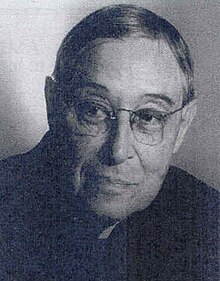John La Farge (Jesuit)
John La Farge , SJ (born February 13, 1880 in Newport , Rhode Island , † November 25, 1963 ) was an American Catholic priest who belonged to the Jesuit order .
Life
He was the son of the artist and author John La Farge (1835-1919), who was a descendant of French refugees. His mother Margaret Mason Perry was from Rhode Island and was a distant relative of Benjamin Franklin .
Writer and journalist
La Farge described himself as a working priest-journalist whose main task was to study and observe the events of the day in order to combine them with deep morality and theological questions. His publications showed the flow of his journalistic writing, which he expressly characterized as that written by a priest and emphasized the priestly perspective. In August 1926 he took over the function of editor for the Jesuit University Magazine in the USA , later became editor-in-chief and managing editor.
Priest training
His career began very early in Newport and continued in New York . In 1897 he took his master degree at the Harvard University and Examinierte in 1901. During his studies he focused mainly on the Latin and Greek classics and published several articles in the Harvard Monthly, the University magazine. In autumn 1901 he began studying theology at the University of Innsbruck , where the Jesuits headed the theology chair. On July 26, 1905, he was ordained a priest in Innsbruck and joined the Jesuit order, after which he returned to the USA, studied for a year at Canisius University in Buffalo and later at Loyola College in Maryland . Here he completed a two-year course at Woodstock College in Maryland with a master's degree in philosophy .
Chaplain
An illness prevented La Farge from continuing his studies and so he initially took on a pastoral activity, which was characterized by 15 years of pastoral work. He used this time to get to know the societal problem areas, which also included racist problems and racial prejudice, in his immediate vicinity. During these years, with the support of some confreres, he attempted to counter the racial conflict by establishing a school for white boys and “negro boys” in the local community. His difficult and drastic experiences in carrying out this project brought him into close contact with the public, with Catholics and non-Catholics and especially with people and agencies who were interested in the education and well-being of the "colored people". As chaplain and priest he had been given important offices; so he had become chaplain of the Liturgical Society of the Arts (1933) and of the Catholic Council on Racial Issues (1934) in New York. He was chaplain of the Society of Catholic Laity and officer of the Catholic Association for International Peace and in 1934 Vice President of the American Catholic Historical Association.
Against racial discrimination
His fame had increased significantly and so he founded a council against racism in New York in June 1934 . Parents who campaigned for a school education free from racism were represented in this council. From this arose the National Catholic Council against Racial Discrimination, whose chairmanship was temporarily taken over by La Farge. His writings and newspaper articles received great and appreciative attention in the USA and in the Vatican , his writings and essays were also discussed in government circles in the USA.
Collaboration on an encyclical
Pius XI. planned to write an important encyclical (" Humani generis unitas ") against racism and, in addition to the Jesuit Gustav Gundlach, had also included La Farge in the deliberations in 1938 . to develop the draft of an anti-racist encyclical. The planned encyclical was published during the pontificate of Pius XI. not published, rather many ideas later went into the encyclical Summi pontificatus of Pope Pius XII. a.
In 1950, La Farge was elected to the American Academy of Arts and Sciences .
Web links
| personal data | |
|---|---|
| SURNAME | La Farge, John |
| BRIEF DESCRIPTION | American Jesuit |
| DATE OF BIRTH | February 13, 1880 |
| PLACE OF BIRTH | Newport (Rhode Island) , Rhode Island |
| DATE OF DEATH | November 25, 1963 |
